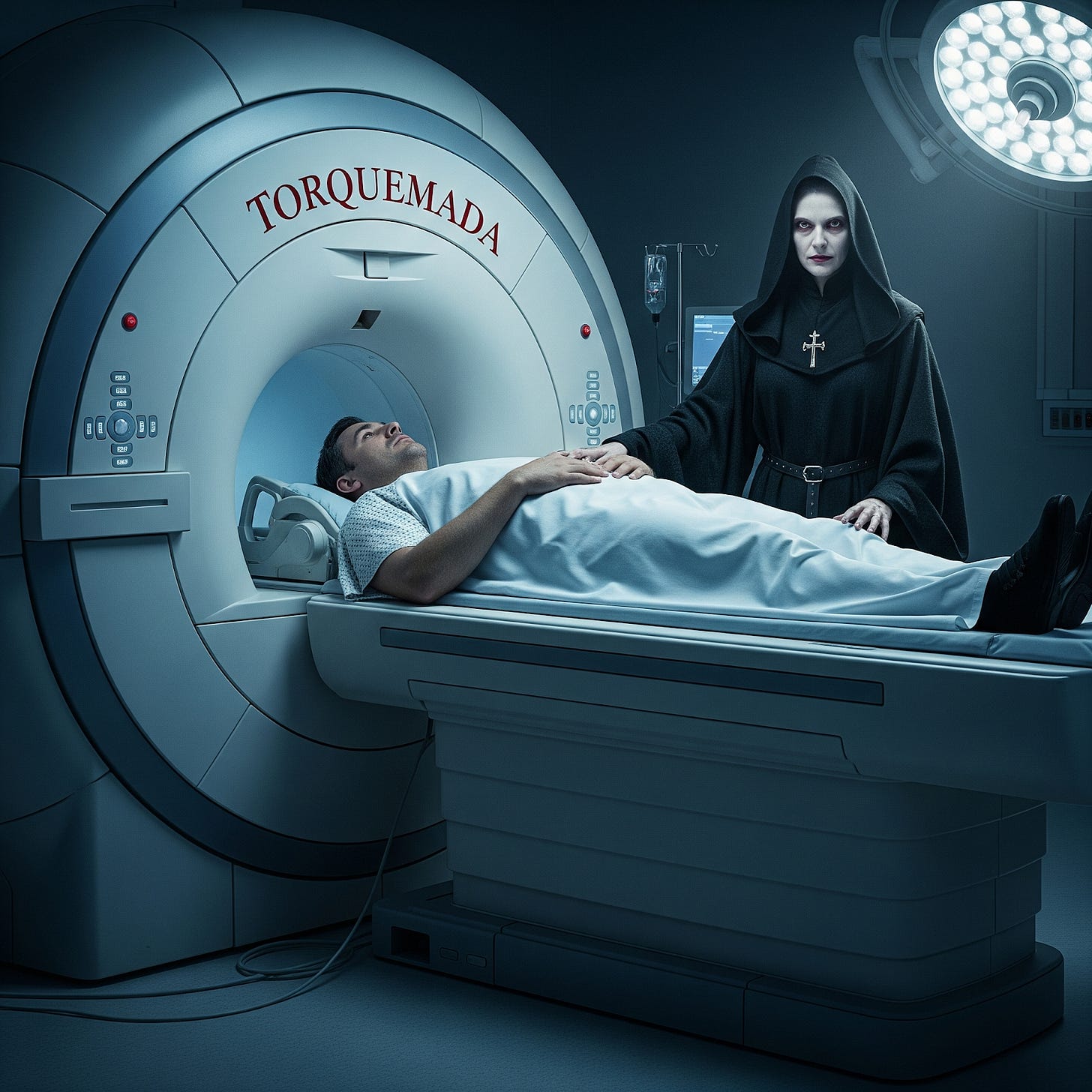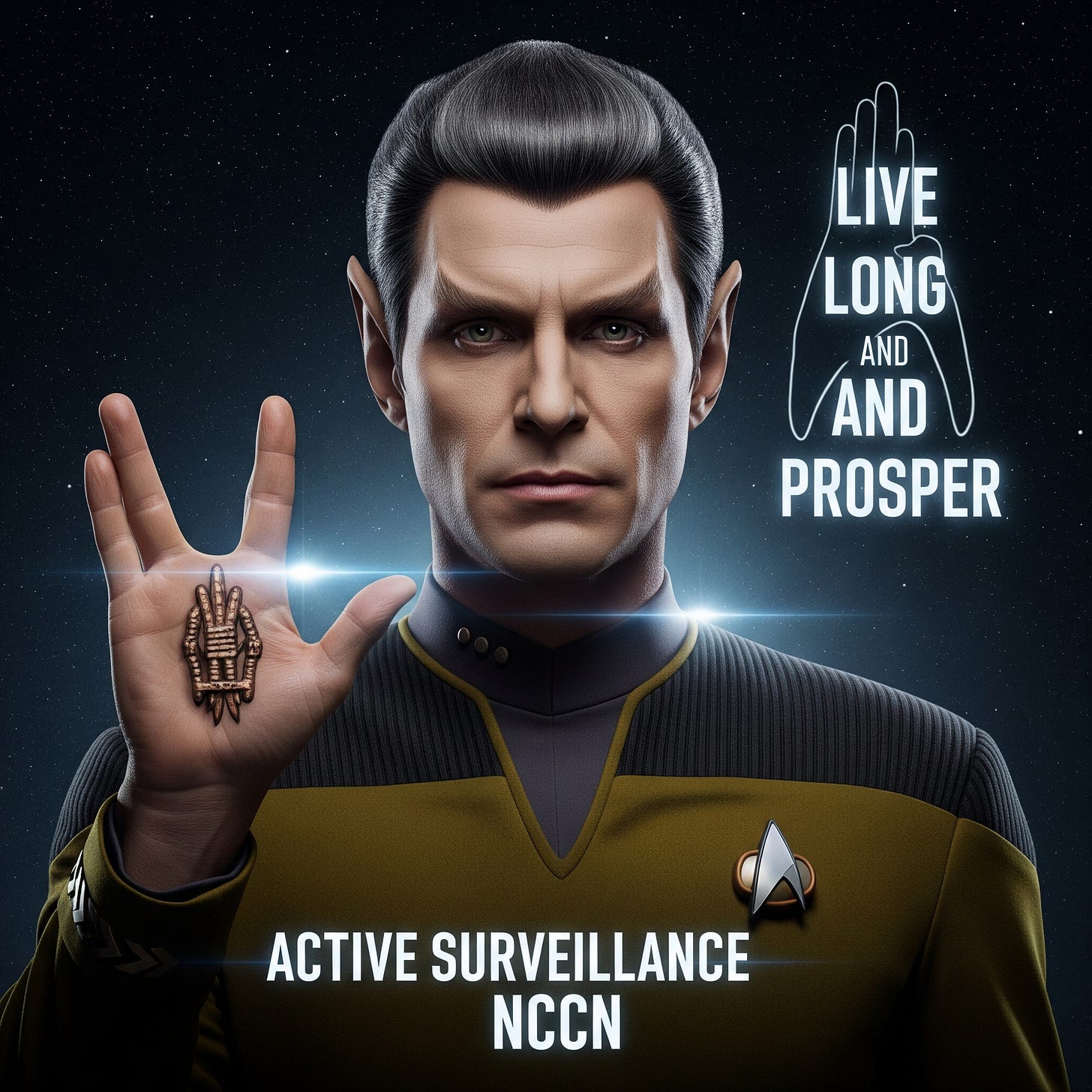Part II How I stopped worrying about claustrophobia and found MRI bliss--And how you can, too
Worried about longevity on AS--new study offers reassurance at 30 years
(Editor’s note: Dealing with claustrophobia is an issue for many of us. See a radiologist’s view of the problem in Part I here. I’ll now share how I conquered my fear of the MRI and hope I can show you the way to MRI bliss or at least MRI tolerance.
Please respond to this brief, confidential survey on your experience with MRIs: https://docs.google.com/forms/d/e/1FAIpQLSd8EAd6CkjLdDr2UrUrlZRweHr-M3J4PCJzvbUK-th2bDavZw/viewform?usp=header —HW )
By Howard Wolinsky
Welcome to my nightmare.
It was a frosty February morn in Chicago in 2011. I was undergoing a multiparametric MRI. I don’t know why, other than it was new tech and maybe it would tell me something about my newly diagnosed prostate cancer.
I was diagnosed with a single core of 1 mm. Gleason 6, low-risk prostate cancer by a urologist who only emphasized the last word--CANCER--and never mentioned the others. He wanted to “cure” my cancer within the week. He had a vacancy in his OR the following Tuesday.
A dashing young University of Chicago urologist, who ran an Active Surveillance clinic, saved me from aggressive treatment and its side effects like urinary incontinence and erectile dysfunction. In those days, 94% of guys underwent in those days--but sent me in the belly of an mpMRI.
We were part of a major public health disaster and didn’t know it.
The U of C receptionist asked if I got claustrophobic. I did.
So I was on edge from the get-go. And the procedure got delayed. Once because they forgot to order the rectal coil. Then, the prior patient in the suite died--and they told me about this already though I clearly already was a jittery puddle of a patient.
Finally, , I got into the tube and could see nothing else. And I could hear nothing else. I was the MRI’s total bitch.
I white-knuckled my way through. Plus the tech made my life miserable. She must have seen my discomfort but showed no compassion. Once, I asked her if she could pause the imaging. She wasn’t happy. about that She yelled at me. “Either we’re going to do this, or we’re not. Make up your mind.”
I called her--to myself--Torquemada, after the Grand Inquisitor who tortured converted Jews and Moors in Spain to get confessions out of them and execute them. He was the symbol of Inquisition’s horror, religious bigotry, and fanaticism. He played a role in some of my ancestors leaving 15th Century Spain, and led to the Monty Python’s comedy bit, “Nobody Expects the Spanish Inquisition.” Fear and surprise, etc.
But the radiologic Inquisition continued. My hearing protection got loose, and I ended up with tinnitus, a ringing in my ears that has not let up in 14 years.
(Welcome to my nightmare: AI-generated image of Torquemada the Grand Inquisitor overseeing undergoing a prostate MRI for a claustrophobic patient.)
I survived. But I ended up with a diagnosis with two tiny apparent lesions--one matching my biopsy sample and the other appearing on the other side of the gland. Famed urologist Dr. Gerald Chodak, a friend, told he’d ignore the results. He thought they were artifacts or false signals.
So I steered away from MRIs. In 2016, I switched urologists. Biopsies were still the rage, and MRIs hadn’t caught on yet.
My new doctor ordered a biopsy--my fourth since diagnosis of PCa--and no cancer was detected in any of them. I had my second post-biopsy MRI at Evanston Hospital outside Chicago. Nothing was found on the MRI.
Secret No. 1: Go in feet first
I found my second MRI was easier. I was still jittery. But being in the machine feet first allowed me to see the ceiling and I easily went through the hour-long scan in 2017.
Suggestion for the MRI Zones: Decorate the ceilings with paintings of blue skies and clouds. Give us something pleasant to stare at. Even a patch of “sky” would be better than sterile non-metallic acoustic ceiling tile.
Nothing was found in the transrectal biopsy or the mpMRI. In those days, MRIs followed biopsies. Insurance wouldn’t cover MRIs unless you had been diagnosed.
So my urologist put me on a MRI and a biopsy vacation that lasted eight years. He deintensified the Active Surveillance protocol--some might call it Watchful Waiting but the intent was surveillance--I only underwent PHI (Prostate Health Index), which includes a regular PSA (prostate-specific antigen) blood test, once a year.
Around this time, patients, and class-action attorneys, began bringing up concerns about the contrast agent used in MRIs. It’s gadolinium and some worried about the chemical passing the blood-brain barrier and causing side effects. Read more here. Radiologists have been trying to reduce gad doses and potential side effects.
(MRI bliss. Per Gemini AI.)
Secret No. 2: Ask your urologist/radiologist team about getting a biparametric MRI
Contrast adds time--15 minutes or more--and expense--$1,000 or more--to the MRI. Some patients with kidney issues couldn’t handle the contrast.
So another non-contrast version of MRI has been used in some cases. This test is known as biparameteric MRI. The contrast aspect is subtracted from the typical and better known multiparametric MRI, creating the two-step, time- and money-saving biparametric MRI.
An interesting thing happens to prostate MRIs without contrast. Small, wimpy lesions, low-risk-cancers, are not visible.
What radiologists say
Antonio Westphalen, MD, Section Chief of abdominal imaging at the University of Washington and UW professor of radiology, and columnist for this newsletter, said he recommends use of gadolinium for the best images, especially establishing a baseline or if a long time has passed between MRIs. He believes it may be OK to skip gad in other cases.
“Most of tumors that are not detected are low grade and low volume,” he said. “I would not say they don’t matter, but they probably will not determine outcome and the window to detect and treat them remains open.”
Silvia Chang, MD, Section Head, Abdominal Imaging, Department of Radiology, Vancouver General Hospital, noted about mpMRIs: “The sensitivity has been reported at around 85% for clinically significant cancer, which is usually Gleason 7 or greater.”
She added: “MRI cannot detect all Gleason 6 cancers and yes, it is not a concern if they are missed.”
Go, biparametric
So biparametric misses the “lame”—as one of my doctors calls them—low-risk Gleason 6 lesions.
I call this a “feature” not a “bug.”
The University of Michigan (Go, Blue!) has adopted biparametric MRIs. See this. The researchers say biparametric reduces tube time to 15 minutes--enough to help some claustrophobic patients to avoid freaking out.
I have been considering leaving AS, which I have been on now for 15 years. I asked a number of the world’s experts on what they recommended I do. Several suggested getting an MRI before making any drastic decisions. But I held back in part because of COVID-19 but also because of my claustrophobia.
My urologist green lighted the biparametric MRI, but warned it could miss clinically significant lesions.
The warning gave me pause.
The hospital really wasn’t set up for biparametric. I received a form for an MRI that obviously was intended for a multiparametric test. This made me nervous. I know how major institutions can mishandle changes in the ordinary routine--I was afraid I would show up at the hospital and find myself being injected with gadolinium.
But it didn’t happen that way.
The head of the department set things up. The techs were aware that I wanted a biparametric test. They said 95% of their patients get contrast, but doing a biparametric test was no big deal for them.
I got in the machine. They carefully put in hearing protection and a tight headset over that--so I could communicate with Vanessa, the helpful tech, and listen, if I chose, to Mozart or anything else. I chose to listen to the magnet noise, which was highly muffled.
Secret No. 3: Communicate with the tech
The test took longer than I expected. 35 minutes vs. 15 minutes in An Arbor. I was in the tube a total of 45 minutes. But I was calm and unbothered--also unmedicated. Some think wearing a metal-free mask or keeping your eyes shut helps.
Secret No. 4--Stay on top of the time factor
After each imaging segment, Vanessa told me how long the next test would take.
I think it helps to have a time countdown so you know how the test is progressing.
It was over before I knew it.
Vanessa said: “It’s about mind over matter.” I quoted Mark Twain from a different context: “If you don’t mind, it doesn’t matter.”
She said the images came out great.
I have campaigned for Active Surveillance to help patients avoid side effects of treatment and elimination of transrectal biopsies to avoid deadly sepsis. I am now adding biparametric to my list of reforms needed in AS and urology/radiology,
Bottom line: The test was a breeze. No worries. And my biparametric results were good—no cancer spotted. I’ll share more soon.
Please respond to a confidential survey on your MRI experience. My headline was inspired by “Dr. Strangelove.”
(AI’s take on NCCN, AS & Spock.)
Live long (and prosper) especially on Active Surveillance--but other PCa patients, too--Swedish stud finds
By Howard Wolinsky
Face it: We don’t get out of here alive.
And when we get diagnosed with prostate cancer, even the low-risk Gleason 6 variety, we may worry about shuffling off this mortal coil sooner rather than later.
Relax. A new Swedish study—looking as far out as 30 years—reports that the Big-C sounds scarier than it is in general, but especially for those of us on Active Surveillance, close monitoring of our cancers.
The Grim Reaper isn’t interested in us. Too busy with heart .disease and other cancers.
The new study shows that if you have localized PCa and your cancer care doctors follow the National Comprehensive Cancer Network (NCCN) guidelines, you likely have a long life ahead. Your PCa isn’t going to kill you.
"This study offers a big sigh of relief for many men facing a prostate cancer diagnosis," said Ahmad Shabsigh, MD, The Ohio State University Comprehensive Cancer Center - James Cancer Hospital and Solove Research Institute. “What's truly striking is that for patients with low-risk prostate cancer, many of whom were on active surveillance, the 30-year mortality risk from the cancer itself was only about 11%. It really underscores the power of evidence-based treatment plans and the importance of focusing on a person's overall health, not just their cancer."
(Shabsigh is an NCCN prostate panelist but was not involved in the research.)
Reassurance comes from a large Swedish study, published in the latest edition of the Journal of NCCN. Researcher report that of patients diagnosed with non-metastatic low-risk prostate cancer later in life, and treated according to NCCN Clinical Practice Guidelines in Oncology, 90% were likely to survive their cancer for their remaining life-expectancy. Of those with non-metastatic higher-risk cancer and a longer life expectancy, that likelihood was still greater than 65%.
"Our data support adherence to guideline recommendations for treatment of prostate cancer," said lead researcher Pietro Scilipoti, MD, of Uppsala University in Sweden and IRCCS San Raffaele Hospital in Italy. "If guideline-recommended treatment is used, most people with prostate cancer will live for many years after diagnosis. That includes active surveillance as an excellent treatment strategy for appropriately selected people."
Researchers studied 62,839 patients diagnosed with non-metastatic prostate cancer in Sweden between the years 2000-2020. All were placed within a defined risk category, had a life expectancy of more than three years, and were treated according to evidence-based, expert consensus-driven recommendations from the NCCN Guidelines for Prostate Cancer.
Those with low- and intermediate-risk cancer were six times more likely to die of other causes than prostate cancer. Those with high-risk cancer were still twice as likely to die of other causes.
Check out the NCCN guidelines: NCCN.org/patientguidelines
Remembering Ken Mason
Human being and PCa patient extraordinaire died recently at age 80 while on a meditation retreat—not from his cancer.
I wrote a tribute:
Now his husband Gary Kebbel has set up a memorial where you can write your own tribute to Ken.
https://www.forevermissed.com/ken-mason/about?short_code=VLBy0n7l
Please share your memories. And maybe some of his jokes.
July webinar: 'Why All Men Diagnosed with Prostate Cancer Should Undergo Germline Genetic Testing'
ASPI (Active Surveillance Patients International) has assembled a panel of genetics experts to address genetic and prostate cancer.
The session will run from noon to 1:30 pm Eastern time on Saturday, July 26.
Please register for the meeting here.
There will be a Question-and-Answer session following remarks by the panel. Please send questions in advance to: contactus@aspatients.org
Please respond to my confidential survey on genetic testing and PCa. Click here: https://forms.gle/Uv9d5gaZYHadZ5Qh9
Also:
Please answer this questionnaire on transperineal vs. transrectal biopsies: https://forms.gle/GShpHwegEPtAVgTs9 I have a relevant story coming, and you can take a few minutes and help if you haven’t already.










You chose another good cause to support for AS, which is biparametric MRI (bpMRI). The scientific evidence is solid for its use in AS now that the results of PRIME are out, showing the test is noninferior to mpMRI. PRIME is an important study to bring bpMRI into the AS mainstream because it was a large prospective multicenter international trial - the kind of trial guideline writers love. Although the PI presented the trial findings at the 2024 AAU annual meeting, the official study has not yet been published in a peer-reviewed journal. This delay isn't unusual for large trials, but I bet the EAU and others like NCCN are waiting for the final published trial findings before adding bpMRI to AS protocol guidelines. I'll bet they adopt bpMRI into their protocols, like the University of Michigan. Most men (except those with contraindications, such as kidney failure or metallic hip implants) receive an mpMRI as their first MRI and then bpMRI as follow-ups. I also bet the guidelines will recommend mpMRI or bpMRI for follow-up MRI, depending on certain circumstances (high-risk) or certain conditions (kidney failure). Companies developing AI programs that interface with bpMRI for prostate cancer are likely to do very well:-))